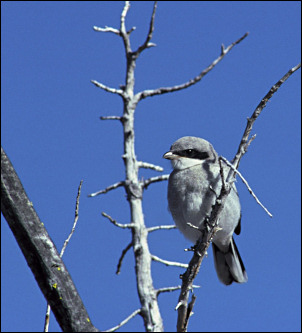
|
Context Kingdom: Animalia |
 |
Loggerhead Shrike (Lanius ludovicianus). Photograph by Dave Menke, courtesy of the U.S. Fish and Wildlife Service. |
Length is about 9 inches, or 23 cm (Sibley, 2000). It has a heavy, hooked bill, with black mask, a gray head, and its back is plump (Reader's Digest, 1990). It has white underparts, black wings with white wing patches, and a black tail with white outer tail feathers. Juveniles and immatures are duller with faint barring above and below (Rappole, 2000).
It prefers open desert areas and scrub, with high perches. Thorns on vegetation or man made barbs are used to store food by serving as hooks for the cache (Ehrlick, 1988).
Lanius ludoviscianus is found throughout the United States and southern Canada, down to the highlands of Mexico to the state of Oaxaca. It winters almost everywhere in its range except for the northernmost parts (Rappole, 2000).
The Loggerhead Shrike eats insects, small mammals, birds, reptiles, and amphibians. It larders or caches prey on thorns and barbs for storage and later use (Ehrlick, 1988).
Its cry is a "chaaa" that is repeated three or four times, and its song is a series of warbles and squeaks. It sits motionless for long periods of time watching for prey, and lacking raptorial talons, it stuns or kills flying birds with a blow from its beak (Rappole, 2000).
It breeds throughout its range (Rappole, 2000), and nests in a cup of twigs lined with animal hair and plant fiber, 3-20 feet above the ground in a bush or tree. A clutch consists of 4-7 eggs, which are whitish buff with brown spots. Incubation is 10-12 days long, and the young leave the nest 20 days from hatching. The male is rigid in keeping his breeding territory, and in general, the bird nests earlier than most passerines. The male feeds the incubating female from his cache of food. That which the female feeds to its nestlings is from the male cache as well. Males and females hold separate territories during the non breeding season (Reader's Digest, 1990).
Ehrlick, P. R., D. S. Dobkin, and D. Wheye. 1988. The birders handbook: A fieldguide to the natural history of North American birds. Simon and Shuster Inc., New York, 785 pp.
Rappole, J.H. 2000. Birds of the Southwest: Arizona, New Mexico, Southern Californa & Southern Nevada. Texas A&M University Press, College Station, 329 pp.
Reader's Digest General Books. 1990. Book of North American Birds. The Reader's Digest Association, Inc., Pleasantville, 576 pp.
Sibley, D. A. 2000. The Sibley guide to birds. Alfred A. Knopf, New York, 544 pp.
Rosalina Ledesma, March, 2006.
